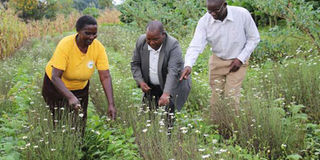Rosy days await pyrethrum farmers

Charles Kerama (centre) and his wife Grace in their pyrethrum farm in Nyaribari Masaba, Kisii. With them is Samuel Matonda, an agribusiness consultant working on reviving the crop. PHOTO | BENSON MOMANYI | NATION MEDIA GROUP
What you need to know:
- Away from the dilapidated building, there is Kiamokama Horticultural Centre, a gleaming structure that stands proud with its tinted windows and ultramodern storage sheds, a harbinger of good times to come for the farmers.
- Pyrethrum is a relatively easy crop to grow when planted in the right type of soils because it does not require inorganic fertiliser and does well with minimum weeding.
Standing next to two storey buildings that will house the sub county hospital in Kiamokama, Kisii, the old colonial building looks misplaced.
Its rusty roof and gutters, broken windowpanes and holes on the walls indicate a long period of neglect.
Inside the building, there are torn papers strewn all over the floor, dusty cabinets and broken chairs.
Years back, the building was the pride of residents as it acted as the pyrethrum buying centre. Farmers would flock the centre to sell their produce or pick their money.
“There was a time this building was a busy place, when pyrethrum was the top cash crop,” says Samwel Matonda, the Kisii County Agribusiness Promotion director. “Farmers used to make good money. We want to bring back the glory, by reviving the growing of the crop,” adds Matonda, a pyrethrum farmer and a consultant for Care Volunteering in Partnership – Kenya, (CAVIP-K), a CBO that trains and sensitises rural communities on agribusiness activities.
Away from the dilapidated building, there is Kiamokama Horticultural Centre, a gleaming structure that stands proud with its tinted windows and ultramodern storage sheds, a harbinger of good times to come for the farmers.
Pyrethrum is a relatively easy crop to grow when planted in the right type of soils because it does not require inorganic fertiliser and does well with minimum weeding.
“At most, the farmer may only be required to apply a small amount of phosphorous to the plants to ensure strong and succulent growth,” says Matonda, noting the cost of purchasing seeds to enable the full revival of the crop across the county is 18 million.
The crop is harvested twice every month, before being dried in the shade for six weeks and it is sold at Sh140 a kilo.
Pyrethrin is, thereafter, extracted from the flowers to produce insecticides that are effective in killing mosquitoes and other harmful insects.
The flower remains are then converted into cattle feed, which can be used to supplement napier grass and other feeds.
“Pyrethrum is grown in high altitude areas with plenty of rainfall and cool temperatures ranging from 20 to 28 centigrade. The Gusii highlands are perfect for the crop.”
According to him, there are over 10,000 farmers willing to cultivate the crop.
The Kisii County government held a meeting with stakeholders last week during which Patrick Lumumba, the chief county administrator, assured farmers that the governor will help in reviving the crop.





